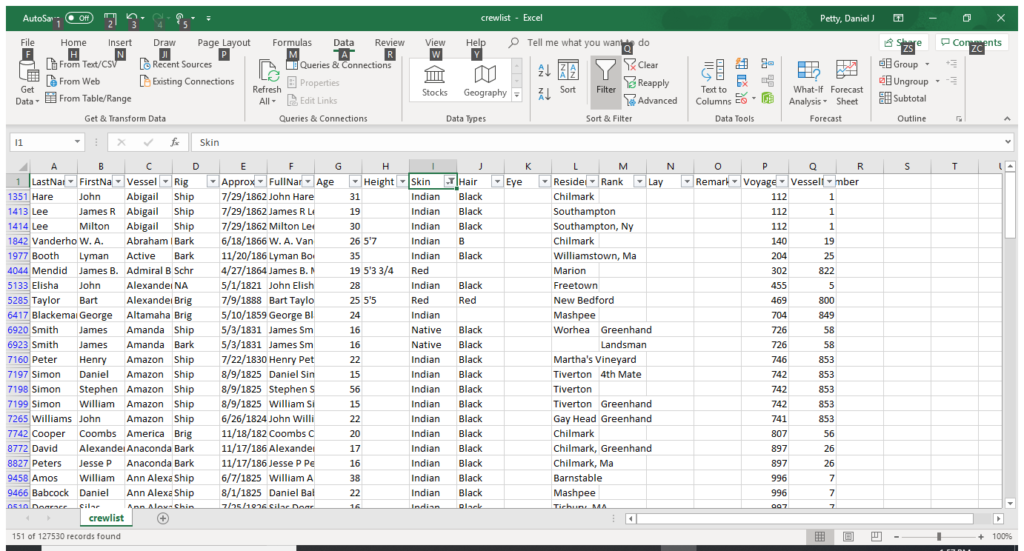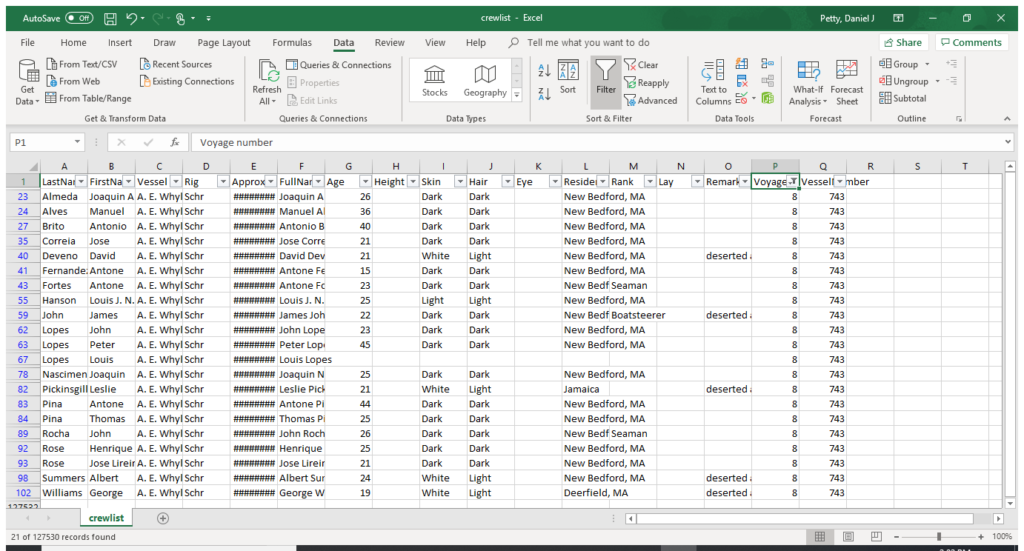Whaling Crew List Database

The Whaling Crew List Database is a collection of over 125,000 identification records of those who sailed from the port of New Bedford on one of the thousands of whaling voyages during the golden age of American whaling. Started by the New Bedford Free Public library through the work of volunteers and currently maintained by the New Bedford Whaling Museum the Whaling Crew List database is one of the largest collections of whalemen records in America
Spanning from 1809 to 1927, the database record vital record of theses sailors as interpreted by customs officials in New Bedford. The Whaling Crew List includes the name, age, vessel boarded, aprox. date of embarkment, and place of residence among its records. These more traditional records are easily sort-able and useful in establishing the commercial and migratory patterns of New Bedford in the 19th and early 20th centuries. Included with the more traditional who, when, where statistical marks are more detailed records of height, hair, skin, and eye color, as well as rank, lay, and other notable remarks. It is in these detailed remarks that the Whaling Crew List becomes a powerful tool for researchers of the American whaling industry and more broadly, the cosmopolitan make-up of American port cities in the 19th century.

Each voyage and vessel are assigned a coded number which can be used to separate individual voyages and uncover the crew of a particular voyage of interest. The data set can be sorted into a variety of different sets and the addition of sailor details like height, skin and hair color, and rank allows for the examination of more narrow questions particularly involving the racial make-up of whaling voyages. Additional comments, noted by either Customs official or archivist also add to the data sets uses, particularly notable are notes of sicknesses, violent deaths, and unique characteristic of employment.

The Whaling Crew List is limited only to those who sailed from New Bedford and does not often report those who either disembarked before return or were picked up along the whaling voyage. As both and desertion and recrewing were prominent during resupplying stops in this era, the Whaling Crew List is only useful in assessing whalemen who were physically in New Bedford at some point. While the Whaling Crew List is comprised of an enormous amount of data, the project is by no means a complete or perfect account of the men who sailed from New Bedford. Due to the nature of customs records, the information collected varies widely within the collection.

Even within the same year, recorded information varies, indicating that there likely were multiple customs officials recording data. Collection differences also vary over the decades, with later years more likely to include detailed information like lay, rank, and color. These collections holes by no means reduce the viability of the Whaling Crew List rater also give insight into the workings of the financial side of the whaling industry as well. The Whaling Crew List Database is altogether an incomplete but vital source of analysis for anyone interested in the whaling industry.
2 Comments
Maeve Kane
The skin color column is worth interrogating more–who do you think recorded that, and what might have affected their perception of race?
Daniel Petty
I agree that it is worth more discussion. I’m fairly certain that this information was recorded by customs officials and/or bureaucratic agents of the New Bedford port commission. As for their reasoning or biases, I think there are multiple reasons but that those reasons shifted over time. The database begins during the first years of the 19th century, during a time of impressment for american sailors and whalers. The detailed records of skin, eye and hair colors could have been used to identify the history and residence of individual sailors as impressment prevention. After 1812 and the shift away from impressment, those record could be remnants or shifted to keep tabs on the racial make up of crews. Because these records were recorded in New Bedford which had been seen as a haven of abolitionism I’m sure that also influenced the skin color categorization. As to how or why, I’m not entirely sure.